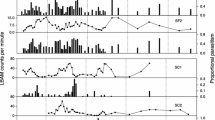Abstract
A population census was conducted to describe the effects of the growth stage of rice on the population dynamics ofS. furcifera, in particular, on immigration, seasonal abundance, population growth rate, and wing-form expression. The number of immigrants was highest on rice plants 17 to 30 days after transplanting (DAT), which suggested that immigrants prefer to settle or remain more on rice plants at the tillering stage (approximately 20–30 DAT). Population growth rate from immigration to the 1st generation decreased with an increase in rice plant age. In contrast, population growth rate from the 1st to 2nd generation was not influenced by rice plant age and was negatively density-dependent. The percentage of macropters (flyers) was positively related to the growth stage of rice when rice was in the vegetative or early part of the reproductive stage, and reached 100% at about 10 days before heading (booting stage). Threafter, most adult females molted into macropters regardless of population density. The roles of host plant age and crowding effect on the population dynamics ofS. furcifera are discussed.
Similar content being viewed by others
References
Cariño, F. O., P. E. Kenmore and V. A. Dyck (1979) The FARMCOP suction sampler for hoppers and predators in flooded rice fields.International Rice Research Newsletter 4(5): 21–22.
Cook, A. G. and T. J. Perfect (1989) Seasonal abundance of macropterousNilaparvata lugens andSogatella furcifera based on presumptive macroptery in fifth instar nymphs.Ecological Entomology 10: 249–258.
Denno, R. F., J. Cheng, G. K. Roderick and T. J. Perfect (1994) Density-related effects on the components of fitness and population dynamics of planthoppers. pp. 257–261.In R. F. Denno and T. J. Perfect (eds.)Planthoppers: their ecology and management. Chapman & Hall, New York.
Hirao, J. (1972) Bionomics of the two injurious planthoppers in a paddy field and suitable timing of insecticide application.Bulletin of the Chugoku National Agricultural Experiment Station. Series E 7: 19–48. (in Japanese with English summary)
Iitomi, A. (1987) Reproduction of the white-backed planthopper,Sogatella furcifera Horváth on the late-season culture of rice.Annual Report of the Society of Plant Protection of North Japan 38: 92–95. (in Japanese with English summary)
Iitomi, A and K. Kodama (1989) Types of population growth of the white-backed planthopper,Sogatella furcifera Horváth and its forecast in Akita prefecture.Annual Report of the Society of Plant Protection of North Japan 40: 91–94. (in Japanese with English summary)
Isizaki, H. and H. Matsuura (1991) Occurrence of rusty rice kernels caused by white-backed rice planthopper,Sogatella furcifera Horváth.Proceedings of the Association for Plant Protection of Hokuriku 39: 51–56. (in Japanese)
Kisimoto, R. (1956) Studies on the polymorphism in the planthoppers (Araeopidae, Homoptera). Preliminary report.Oyo-Kontyu 12: 56–61. (in Japanese with English summary)
Kisimoto, R. (1965) Studies on the polymorphism and its role playing in the population growth of the brown planthopper,Nilaparvata lugens Stål.Bulletin of the Shikoku Agricultural Experiment Station 13: 1–106. (in Japanese with English summary)
Kisimoto, R. (1976) Synoptic weather conditions including long distance immigration of planthoppers,Sogatella furcifera Horváth andNilaparvata lugens Stål.Ecological Entomology 1: 95–109.
Kuno, E. (1968) Studies on the population dynamics of rice leafhoppers in a paddy field.Bulletin of the Kyushu Agricultural Experiment Station 14: 131–246. (in Japanese with English summary)
Kuno, E. (1979) Ecology of the brown planthopper in temperate regions. pp. 45–60.In:Brown planthopper: threat to rice production in Asia. International Rice Research Institute, Los Baños, Philippines.
Kuno, E. and N. Hokyo (1970) Comparative analysis of the population dynamics of rice leafhoppers,Nephotettix cincticeps Uhler andNilaparvata lugens Stål, with special reference to natural regulation of their numbers.Researches on Population Ecology 12: 154–184.
Matsumura, M. (1991) Characteristics of recent population growth patterns of the white-backed planthopper,Sogatella furcifera Horváth in the Hokuriku district.Proceedings of the Association for Plant Protection of Hokuriku 39: 47–50. (in Japanese)
Matsumura, M. (1994) Effect of rice plant stage on wing dimorphism in the whitebacked planthopper,Sogatella furcifera Horváth (Homoptera: Delphacidae).Proceedings of the Association for Plant Protection of Hokuriku 42: 54–56. (in Japanese)
Murai, T., N. Abe, N. Oyama and K. Sakaiya (1986) Notes on the outbreaks of white-backed planthopperSogatella furcifera Horváth and small brown planthopperLaodelphax striatellus Fallen in Aomori prefecture.Annual Report of the Society of Plant Protection of North Japan 37: 131–134. (in Japanese)
Naba, K. (1991) Frequent outbreaks and population growth patterns of the white-backed planthopper,Sogatella furcifera Horvath in recent year.Plant Protection Japan 45: 41–45. (in Japanese)
Noda, H. (1986) Damages of ears of rice plant caused by the white-backed planthopper,Sogatella furcifera (Homoptera: Delphacidae).Applied Entomology and Zoology 21: 474–476.
Noda, H. (1987) Bionomics of the white-backed planthopper,Sogatella furcifera (Homoptera: Delphacidae) and its damage to rice plant and kernels.Bulletin of the Shimane Agricultural Experiment Station 22: 82–99. (in Japanese with English summary)
Sakagami, Y. and R. Korenaga (1981) “Triangle Method”, a simple method for the estimation of total effective temperature.Japanese Journal of Applied Entomology and Zoology 25: 52–54. (in Japanese with English summary)
Sogawa, K. and T. Watanabe (1989) Outline of long-term yearly fluctuations of the rice planthopper occurrence from light-trap data at Kyushu National Agricultural Experiment Station.Proceedings of the Association for Plant Protection of Kyushu 35: 65–68. (in Japanese)
Watanabe, T., K. Sogawa and Y. Suzuki (1994) Analysis of yearly fluctuation in the occurrence of migratory rice planthoppers,Nilaparvata lugens Stål andSogatella furcifera Horváth, based on light-trap data in northern Kyushu.Applied Entomology and Zoology 38: 7–15. (in Japanese with English summary)
Widiarta, I. N., Y. Suzuki, H. Sawada and F. Nakasuji (1990) Population dynamics of the green leafhopper,Nephotettix virescens Distant (Hemiptera: Cicadellidae) in synchronized and staggered transplanting areas of paddy fields in Indonesia.Researches on Population Ecology 32: 319–328.
Author information
Authors and Affiliations
Rights and permissions
About this article
Cite this article
Matsumura, M. Population dynamics of the whitebacked planthopper,Sogatella furcifera (Hemiptera: Delphacidae) with special reference to the relationship between its population growth and the growth stage of rice plants. Res Popul Ecol 38, 19–25 (1996). https://doi.org/10.1007/BF02514967
Received:
Accepted:
Issue Date:
DOI: https://doi.org/10.1007/BF02514967




